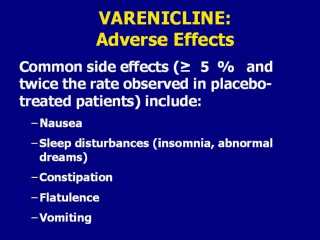| front |1 |2 |3 |4 |5 |6 |7 |8 |9 |10 |11 |12 |13 |14 |15 |16 |17 |18 |19 |20 |21 |22 |23 |24 |25 |26 |27 |28 |29 |30 |31 |32 |33 |34 |35 |36 |37 |38 |39 |40 |41 |review |
 |
Common side effects (≥5%
and twice the rate observed in placebo-treated patients) include: Nausea (30%) Sleep disturbance (insomnia 18%; abnormal dreams 13%) Constipation (8%) Flatulence (6%) Vomiting (5%) Note to instructor(s): Per the manufacturer’s prescribing information, nausea was the most common adverse event associated with varenicline treatment. Nausea was generally described as mild or moderate and often transient; however, for some subjects, it was persistent over several months. The incidence of nausea was dose-dependent. Initial dose titration was beneficial in reducing the occurrence of nausea. Approximately 3% of subjects receiving varenicline 1 mg bid discontinued treatment prematurely because of nausea. For patients with intolerable nausea, dose reduction should be considered. Pfizer, Inc. (2006, May). Chantix Package Insert. New York, NY. Slide is used with permission, Rx for Change: Clinician-Assisted Tobacco Cessation. Copyright © 1999-2007 The Regents of the University of California, University of Southern California, and Western University of Health Sciences. All rights reserved. |